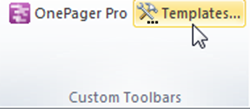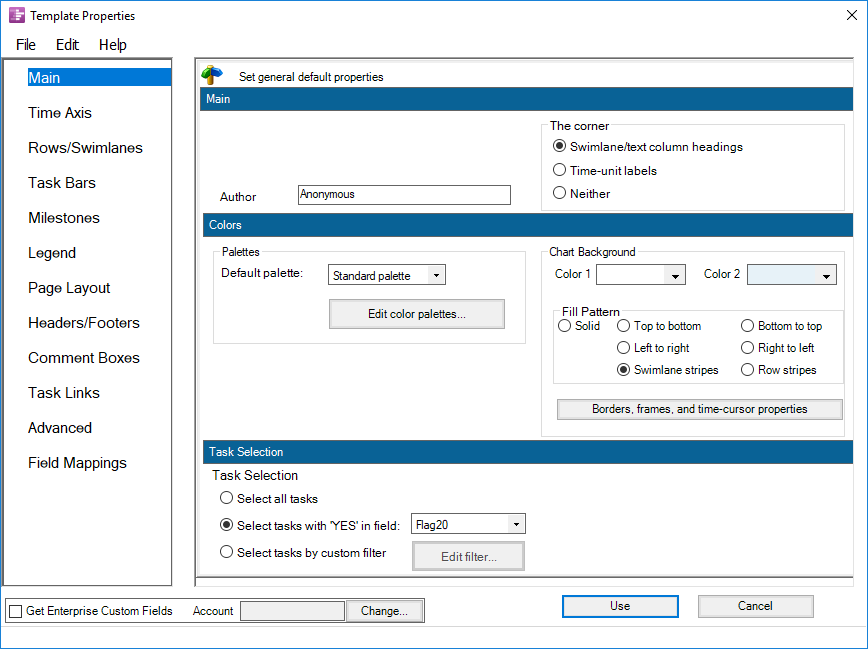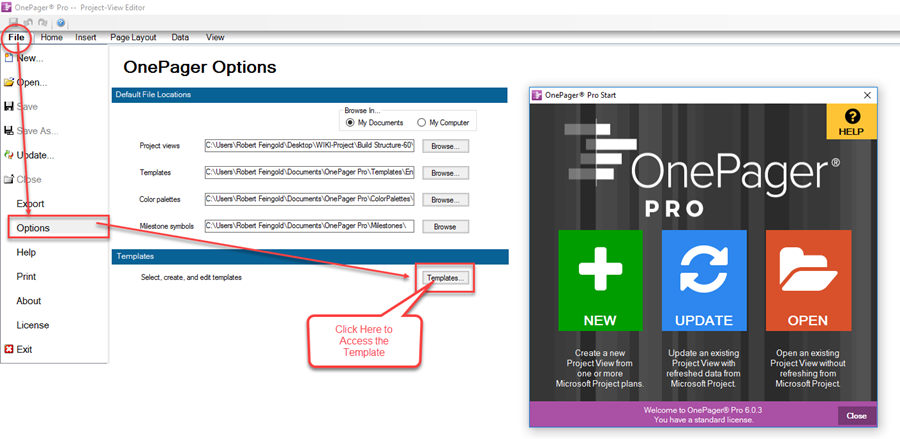Managing Templates for Version 7.0 (Portal)
Contents
About Managing Templates
What is a Template?
1) For OnePager, a Template is a general set of style rules that can be used to create different project views.
2) For example, if you have several projects and need to create the same style of report for each one, a Template allows you to create a single style that can be applied across multiple charts.
3) It is the Template from which a new chart is created and from which all of the settings in the Chart Properties form are initially populated.
4) The Template is also the place where you have the largest number of Microsoft Project or Microsoft Excel source plan fields from which to import into OnePager.
5) A Template is a great way to achieve standardization across projects and across people!
6) If everyone starts with the same Template, then the resulting charts adheres to standards that make it much easier for your audiences to digest.
7) For more information on the differences between a chart and a Template, please see the article at: Templates versus Charts 4.0.1.3-70.
Managing Templates
8) Standard Templates are distributed with OnePager and installed on your computer.
9) These standard Templates options, when selected, can create various visual presentations of your Microsoft Project or Excel data that can meet your schedule discussion needs.
10) The standard Templates can also form starting points for you to create your own Templates which, in turn, create chart visualizations of project data specifically tailored to your needs.
11) The distributed standard Templates, for the most part, contain the same controls and options as the Chart Properties form that is the computer data representation of the chart managed by the Chart Editor.
12) There are, however, differences in the content, controls, and features between OnePager Templates and the Chart Properties form.
13) For more instructions on Template only features, please see the articles shown in the links below:
| Template Only Features-OnePager Pro 24.1.1-70 | Template Only Features-OnePager Express 24.2.1-70 |
Accessing the OnePager Template
1) Templates distributed with OnePager Pro and Express can be accesses for review, editing, and saved in two ways:
- a) From the OnePager Pro (OPP) and Express (OPX) Add-in applications and
- b) From the OnePager Pro (OPP) and Express (OPX) Desktop applications.
Accessing the OnePager Template from the Add-in Application
2) To access, review or edit the Template from the OnePager Add-in application, click the Templates… button on the Microsoft Project ribbon's Add-ins tool bar for OPP or click the Microsoft Excel ribbon's Add-instool bar for OPX.
3) The Template… button for OPP is shown below:

4) Clicking the Template button shown above for either OPP or OPX accesses the current Template form as shown here:

5) The current Template form is displayed on top of your Microsoft Project or Excel source plan and can be reviewed, edited, or saved after editing using the File, Edit, or Help buttons on the Template form's tool bar as shown above.
6) If any edits are made to the accessed current Template, these edits can be made permanent by using the Save button at the bottom of the form after all edits are accomplished.
Accessing the OnePager Template from the Desktop Application
6) Since the Desktop versions of OPP and OPX are launched from desktop icons on your computer, either of these Desktop applications needs to be launched first before access can be gained to the current Template.
7) Launching either OPP or OPX Desktop accesses the respective Chart Editor that is blank and the OnePager Pro or Express Start form
8) To review or edit the Template from the OnePager Desktop application, click the File tab on the Chart Editor's ribbon screen and then the Options tab on the set of tabs on the left side of the screen as shown here:

9) Clicking the Template... button as shown above accesses the Template Properties form for editing as illustrated below:

10) If any edits are made to the accessed current Template, these edits can be made permanent by using the Save button at the bottom of the form after all edits are accomplished.
11) Illustrated above are the steps for accessing the Template associated with the OPP Desktop application.
12) The same steps are used to access the OPX Desktop application’s Template.
Customizing the OnePager Template
1) The Template has the same tabs as the Chart Properties form and on each tab, for the most part, the controls on the Template form mirror those on the Chart Properties form.
2) You can customize any distributed Template to have your charts start out with a common look and use a standard set of Microsoft Project fields.
3) For OPX this also applies to Microsoft Excel fields.
4) Editing within the Template form involves accessing the specific tab and using the control group controls within the tab to change the settings and checkboxes to meet you visualizations intent.
Similarity of the Chart Properties Form
5) Since the Template's controls are so similar to those of the Chart Properties form, we recommend that you reference the articles dealing with Editing the Chart Properties form at: Editing with the Chart Properties form (Portal) 21.0.1-70.
Special Features on the Template Form
6) There are three special feature controls on the Template only that need to be set in the current Template if the feature is to be used in the creation and subsequent update of charts.
Enterprise Custom Fields
7) For OnePager Pro only, the product supports access to Enterprise Custom Fields that typically reside in an enterprise server.
8) All OnePager Pro Template forms have controls for accessing these Enterprise Custom Fields.
9) For more information on the access and use of Enterprise Custom Fields for OnePager Pro, please see the article at: Using Enterprise Custom Fields from Microsoft Project for OnePager Pro 24.3.1-70
Field Splitting and Column Parsing
10) The Field Splitting feature allows you to duplicate tasks when a tasks in your Microsoft Project or Microsoft Excel source plans are assigned to multiple resources (or anything else).
2) Because assignments from Microsoft Project or Microsoft Excel can often be comma-delimited, this feature enables OnePager to parse the comma-delimited list and create a unique task for each instance in the comma-separated list.
3) If you anticipate using the Field Splitting and Column Parsing feature of OnePager Pro or Express, there are setup requirements to be made in the OnePager Pro or Express Template you intend to use.
4) For more information on setting up the Field Splitting and Column features for OnePager Pro and Express, please see the articles at:
| Splitting and Parsing Fields-OnePager Pro 24.4.1-70 | Splitting and Parsing Fields-OnePager Express 24.5.1-70 |
Managing the Current Template
1) As mentioned, Templates are key to managing a standard look and feel for charts produced by individuals and organizations when communicating schedule issues.
2) This being the case, the management of Template forms as objects is an important subject that is presented in the article at: Managing the Current Template 24.6.1-70.
Related Links
Templates versus Charts 4.0.1.3-70
Template Only Features-OnePager Pro 24.1.1-70
Template Only Features-OnePager Express 24.2.1-70
(24.0.1-70)